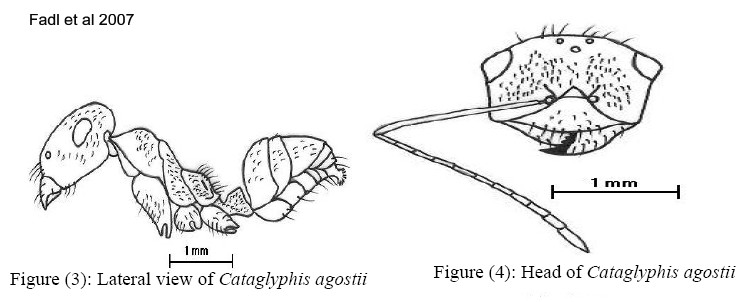 Sharaf's
(2007) description is at Sharaf's
(2007) description is at 
Originally thought by Sharaf to be Cataglyphis
minimus, that now is deleted from the known Egyptian species.
Holotype: 1 worker, Egypt, Gebel Ras Abuhebeig, Gebel
Serbaal, S.Sinai 23.V.1997; M. R. Sharaf (SHC). Type locality: Egypt,
Gebel Ras Abuhebeig, Gebel Serbaal, S.Sinai.
Measurements of Holotype: TL 10.79 mm, HL 3.32, HW 2.73,
SL 3.56, SI 130.4
*Diagnosis: (Fig.53, 54) - WORKER: Colour dark brown,
anterior part of the head and the distal part of the femur yellowish;
antennae, mandibles and tarsi clear yellow; femur brown or pale brown.
Head longer than broad; the area between the short frontal carinae
finely longitudinally striated; the whole head with fine sculpturation;
mandibles smooth and shining, longitudinally striated, armed with five
strong brown teeth and having many long yellow hairs; posterior part of
clypeus having a pair of long yellow hairs; occiput straight with four
pairs of hairs. Pronotum with one pair of short hairs, mesonotum bare,
propodeum moderately low with 9 long yellow hairs. Petiole is a
truncated node with a flat dorsal surface sloping forward, with
relatively dense whitish pubescence in the dorsal and lateral sides,
also two pairs of erect hairs. Gaster globular and shining; the first
gastral tergite bare while the second has one pair of hairs at the
posterior margin; the end of the gaster has a few long scattered yellow
hairs.
Etymology: This species is named after the very kind
Swiss ant taxonomist, Dr. Donat Agosti, the specialist of the genus Cataglyphis,
research associate, American Museum of Natural History, New York.
Remarks: This species was collected from an elevated and
semi-isolated site on Gebel Sebaal, over 1500 m, and was found nesting
under a rock. Only one individual was collected (the holotype).
|